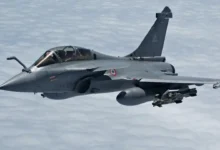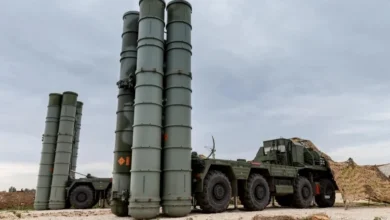ASMPA Nuclear Missile Was Successfully Tested By France From A Rafale Fighter Jet.

France, being a member of the Western bloc and a major military force in Europe, has always prioritised homegrown armaments and self-reliance. Apart from the United States, it is the only country in the Western military with an air-based nuclear force. On March 23, France conducted a test of the enhanced ASMA-P airborne nuclear missile, which was launched from the Rafale fighter jet.
A French Air Force Rafale fighter jet took off from the Cazaux (120th Air Force Base) airstrip in southwestern France, next to the Atlantic Ocean, on March 23, according to the French Armed Forces Ministry. The test of a “Improved Medium-Range Strategic Air-to-Surface Missile/ASMP-A” was successful. The Directorate General of Armament conducted this test.
The ASMP-A medium-range nuclear air-to-ground missile, which replaced the older free-fall AN-22 bomb on France’s Dassault Mirage IV aircraft and the AN-52 bomb on the Dassault Super Étendard, entered service in May 1986. A total of 84 firearms are on hand. The Dassault Mirage 2000N, Rafale, and Super Étendard are the carrier aircraft. The ASMP was carried by the Mirage IVP until it was retired in 1996.
In May 2009, the ASMP medium-range nuclear air-to-ground missile was upgraded and commissioned. It’s a liquid-fueled ramjet-powered supersonic air-to-ground missile. The ASMP missile is a descendant of the ANF supersonic anti-ship missile, which France failed to deploy at the time, and its air intakes on both sides are identical to the ANF.
Both sides of the ASMP-A have air intakes, and the overall configuration is similar to that of ANF missiles.
The ASMP and ASMP-A are 5.38 metres long and weigh 860 kg. The Mirage IV supersonic strategic bomber’s standard weapon was this missile. In 1996, the Mirage IV was released. The Mirage 2000N, which was commissioned in 1988, carried the same missile after it was no longer used for air-based nuclear deterrence. After 2009, the freshly commissioned Rafale was equipped with the enhanced ASMP-A. Both the Mirage 2000N and the Rafale are capable of carrying one ASMP or ASMP-A underbelly.
The missile’s modest size, however, has drawbacks. This missile’s range is extremely “restricted.” The initial ASMP missile had a low range of only 300 kilometres and a TN81 thermonuclear warhead (hydrogen bomb) with a yield of 10 to 300,000 tonnes, which is more than ten times that of the “Little Boy” dropped on Hiroshima, Japan in 1945. In 2009, the ASMP-A, which first flew on the Mirage 2000N and Rafale, improved its range to 500 kilometres and converted to a new TNA nuclear warhead, with 54 built as of 2015.
The French Ministry of Defense has a characteristic termed “enhanced” on the ASMP-A tested this time, which could be the ASMPA-R (R stands for refurbished) missile that has been in development since 2016. It’s still a “minor change,” but it extends the missile’s range and adds a new 300-kt thermonuclear warhead.
Many experts believe France is testing this missile in the midst of the Ukraine-Russia conflict. However, you should be aware that Paris is around 2,400 kilometres from Moscow. To avoid the S-400 and S-500 long-range surface-to-air missiles with a range of up to 400-500 kilometres, Rafale fighter jets must carry ASMP-A in other nations’ airspace as near to the Russian border as feasible.
France has ordered Ariane Aerospace Group to create a new type of airborne nuclear air-to-ground missile, the ASN4G, to replace the ASMP-A in recent years. It’s a hypersonic cruise missile with a range of 1,000 kilometres or more. The ASN4G missile is still under development and is not straightforward to construct.
The French nuclear force is located in the air and has been operational for nearly 60 years. The French Air Force formed the “Strategic Air Force Command” in 1964. By 1968, 62 Mirage IV supersonic strategic bombers had been assigned to nine air bases across France, with nine of them being operational for a long time (1 per base). The Mirage IVs have a short range, however Boeing KC-135 tankers supplied from the US allow them to execute long-range nuclear assault missions.
The French Air Force’s Mirage IV, which was deployed for air-based nuclear deterrence missions for a long period, only used nuclear bombs such the AN11, AN22, and AN52, and the penetrating capacity was concerning. The strategic bomber has developed the subsonic AGM-86 “air-launched cruise missile” and the Kh-55 airborne nuclear cruise missile with a subsonic speed and a range of up to 3,000 kilometres, which has greatly improved the air-based nuclear deterrence capability of the old strategic bomber in the 1980s.
After receiving the Mirage IV with ASMP missiles in 1986, it now has capabilities comparable to those of the United States and Russia. In 1996, France deactivated 18 S3 land-based medium-range ballistics with a range of 3,500 kilometres on the Albion Plateau, which could cover the majority of the Soviet Union. France relied more on air-based nuclear deterrent with the nuclear missile silo (which only went into service in 1982). Despite the fact that the ASMP missiles’ performance is poor, France continues to deploy them as a “heirloom” weapon.
With the retirement of the Mirage 2000N fighter jet, the French Air Force has designated two squadrons of the 98 Rafale B (two-seat)/C (single-seat) fighter jets currently in service as “Strategic Air Forces” Command” to carry out the nuclear mission: the 1/4 “Gascogne” squadron and the 2/4 “Lafayette” squadrons, both based at the Saint-Dizier-Robinson Air Force Base in
It’s worth noting that the French Naval Air Force’s Rafale M carrier-based fighter fighters can also carry ASMP-A medium-range nuclear air-to-ground missiles. Hopefully, however, that day will never arrive.







Facebook Comments